| Monjin Trey with Shaolin Monk |
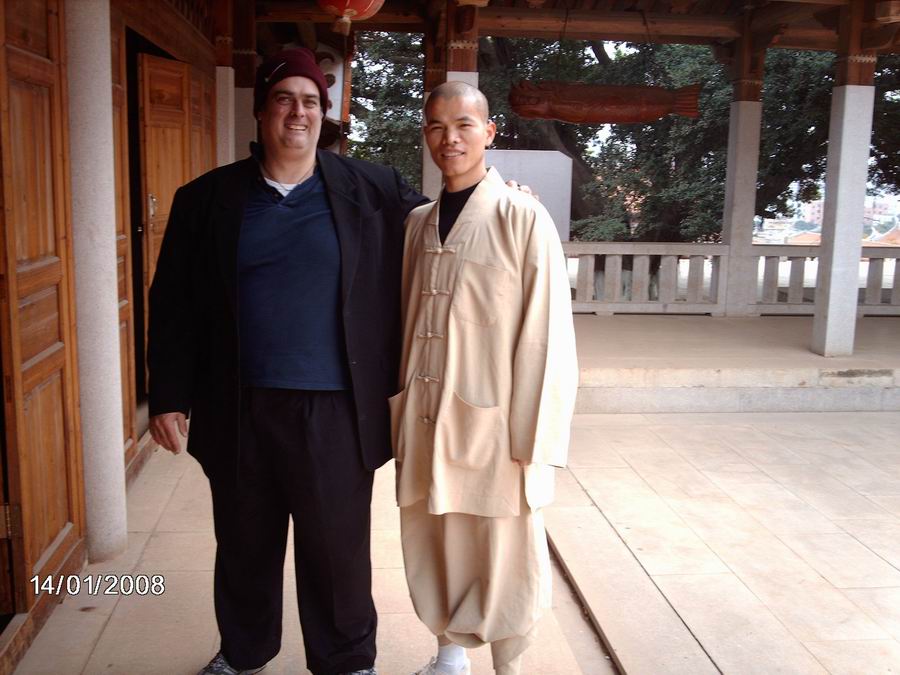
|
| Shiroto Ellen in The Shaolin Temple |
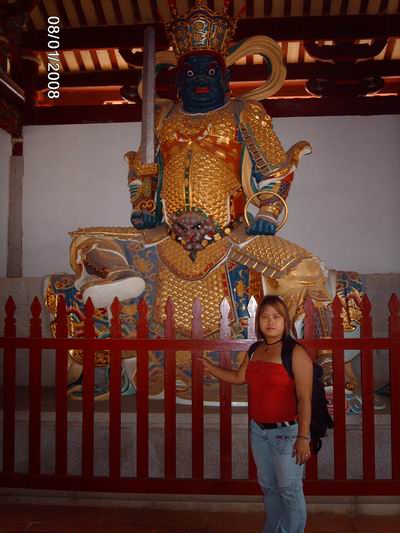
|
On the
8th and 12th of January, 2008, Shiroto Ellen and I, Monjin Trey, visited the South Shaolin temples of
Quanzhou,
Fujian, China in an truly
historic event. In addition to making contributions to aid in the reconstruction of the main South Shaolin Temple (which was burned by decree of Emperor Qianlong, 4th emperor of the Qing dynasty, in 1763, and whose extensive
reconstruction began on October 13, 1992, continuing into the present), we were also able to learn of many connections between
Konigun Ninjutsu and Shaolin Kung Fu, hereinafter documented.
The other
2 lesser Shaolin temples which we were able to visit are the Chongfu Shaolin Temple and the Dongchan Shaolin Temple.
We are presently investigating to determine if there are any more Shaolin temples remaining in the city of Quanzhou,
and planning to visit any other Shaolin Temples there and throughout the Fujian
Province.
| Chongfu Shaolin Temple Gate |
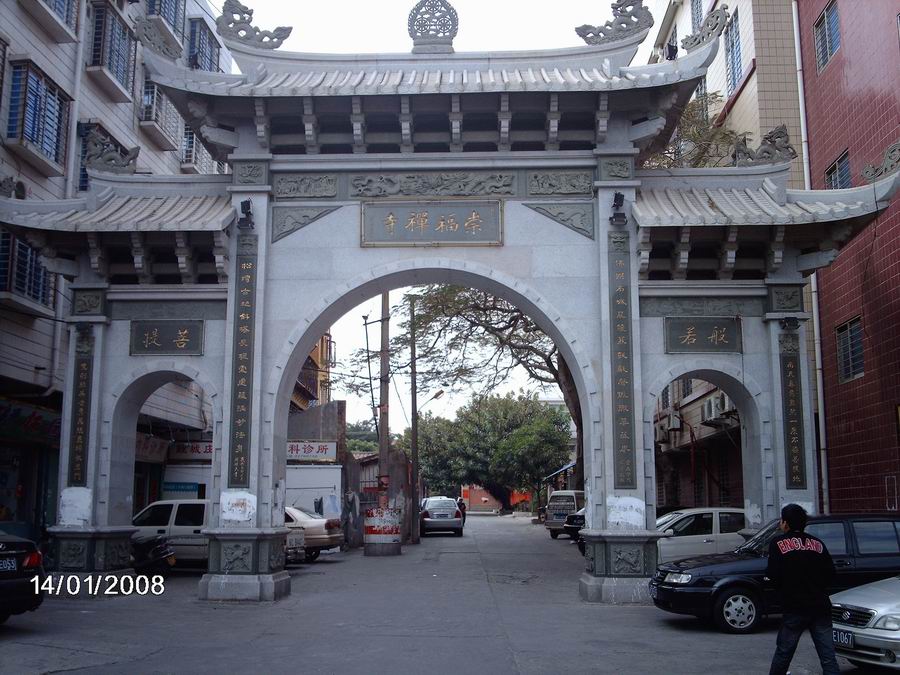
|
| Shaolin Buddha Making Warfist |
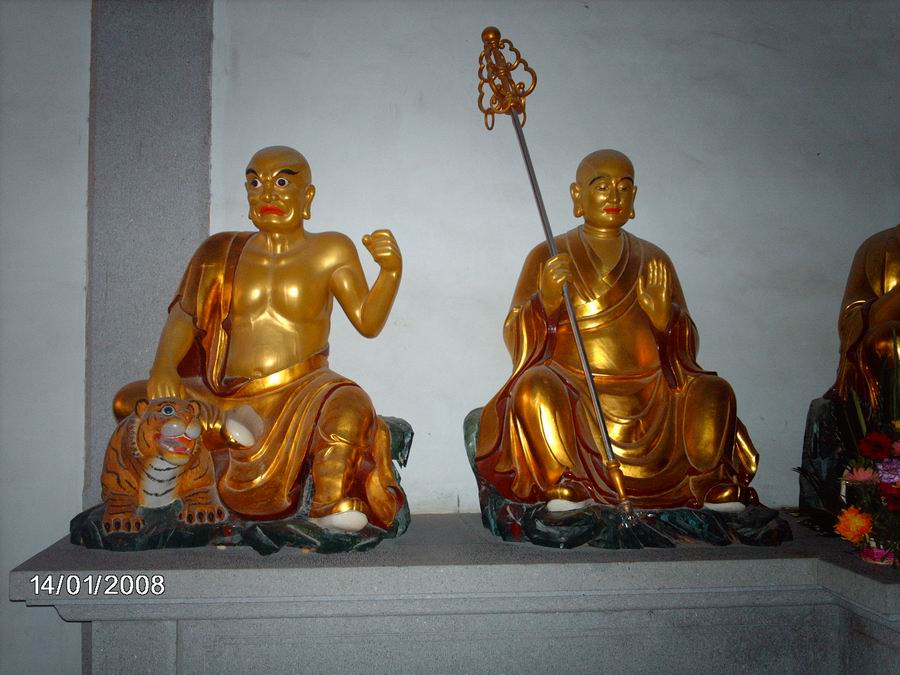
|
| Shaolin Buddha with Tiger |
In the
Chongfu
Shaolin Temple we enjoyed the
beauty and heritage, but only found one significant piece of evidence of the connection between Konigun and Shaolin. This
was, as shown above, a golden statuette of a Buddha making a war fist (whose thumb position would later be modified by Konigun
to better protect the thumb) with a tiger (an important Konigun symbol) at his side. On this Buddha’s right is another
Buddha wielding an imperial scepter as a weapon, illustrating the significance of being able to use anything as a weapon-
an important defining characteristic of both Konigun Ninjutsu and Shaolin Kung Fu.
We only
encountered one monk in the Chong Fu temple, who informed us that most of his comrades had already moved to the main Shaolin
temple.
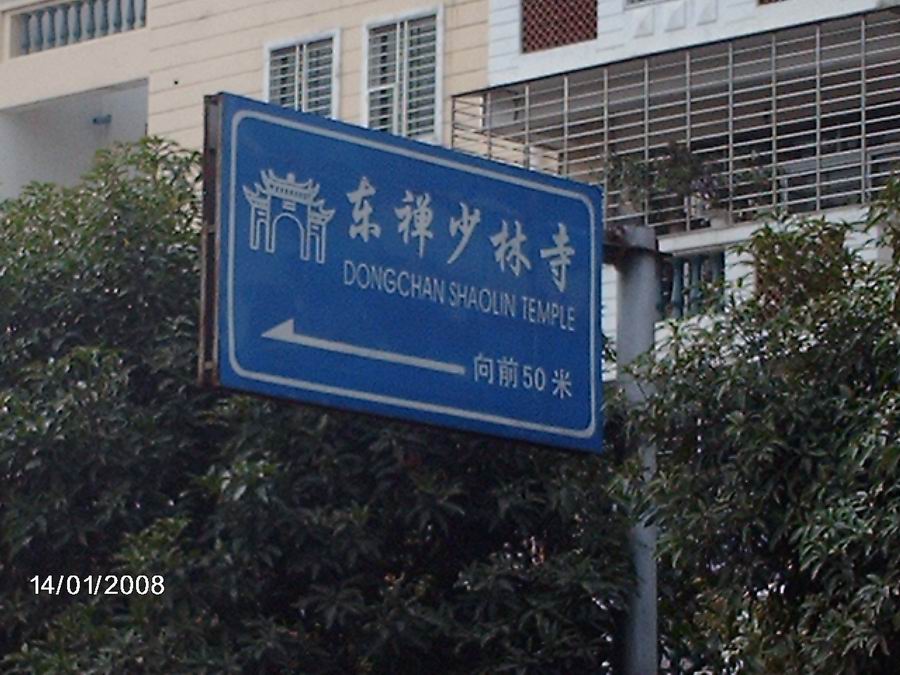 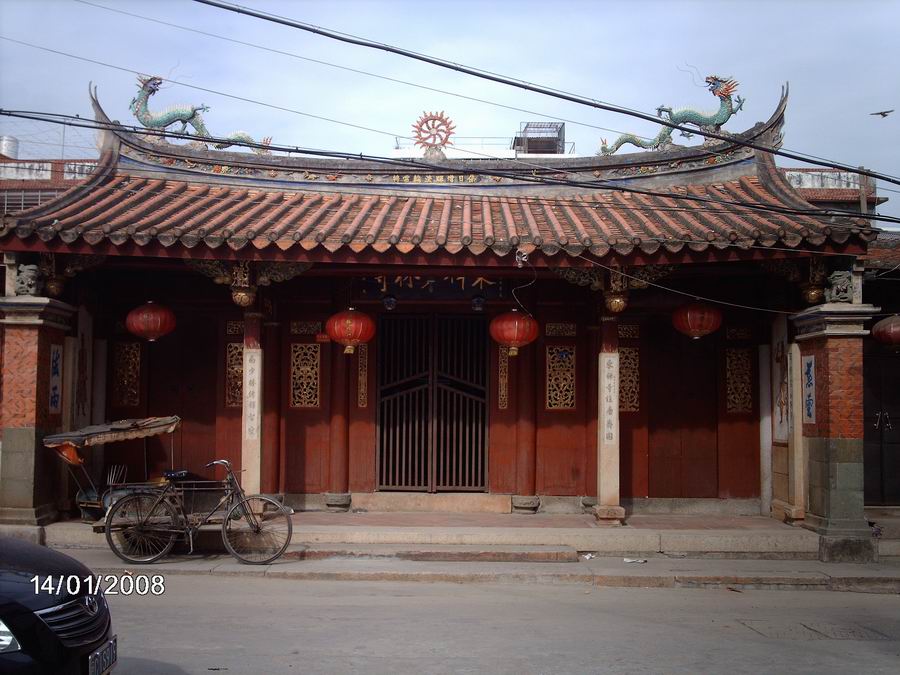
The Dongchan
Temple is small and simple but quite ornate, and was unattended save
by a cleaning lady and a loquacious but innocuous medium - sized watch mutt on
a four foot leash, complete with a wagging tail to punctuate its barking. The ancestral hall was also guarded by the usual
lion statues, but in this case, one of the lions had been either destroyed or absconded with, and a dutiful potted plant was
vigilantly standing watch in its stead.
The primary
item of significance in establishing the relationship between Konigun and Shaolin at the Dongchan temple was the placard shown
above, which is mounted on the temple’s front entrance. It displays a warrior wielding a straight sword similar to the
one used in Ninjutsu, as well as a sash being brandished as a weapon.
Nearby
the Chong Fu temple stands a modest, well preserved stone house which, due to the sign in front of it, we gathered to be of
some historical import. However, in the absence of an interpreter, we were unable to determine its significance. We would
be much obliged if any visitors who speak Mandarin would be so kind as to translate it for us.
In the main Temple we were finally able to meet the fabled Shaolin monks
in great abundance. Their austere appearance was definitely overcome by their jovial manner.
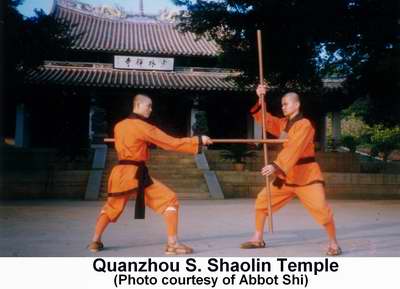
The Southern
Shaolin Temple is presided over by Abbot Changding. Abbot Changding is an amazing man who, in addition to being the head of
the Shaolin Monks, is also doing great good in his community as a member of the Quanhou municipal People’s Political
Consultative Conference. He is using his position there to lobby for UNESCO recognition of the Shaolin
Temple’s role in world cultural heritage. This will be a tremendous
achievement not only for the Shaolin Temple
and its monks but for the entire martial arts community. As it is determined by UNESCO that Shaolin Kung Fu is indeed worthy
of recognition for its contribution to its nation’s culture and history, Ninjutsu will surely follow suit, as well as
many other martial arts that played a vital role in shaping histories and cultures. We support Abbot Changding 100% in this
lofty endeavor, and will do all we can to assist therein.
The monks
were extremely friendly, helpful and cheerful, bending over backwards to assist us despite the language barrier. It was truly
a privilege to meet with these remarkable individuals.
On a humorous aside, one of the monks standing at the table was holding a wallet with a fat wad of 100 RMB notes. As
I trained my camera on the wallet, however, it quickly disappeared back into his robe and the monk grinned sheepishly. Laying
up treasures in Heaven, I suppose.
 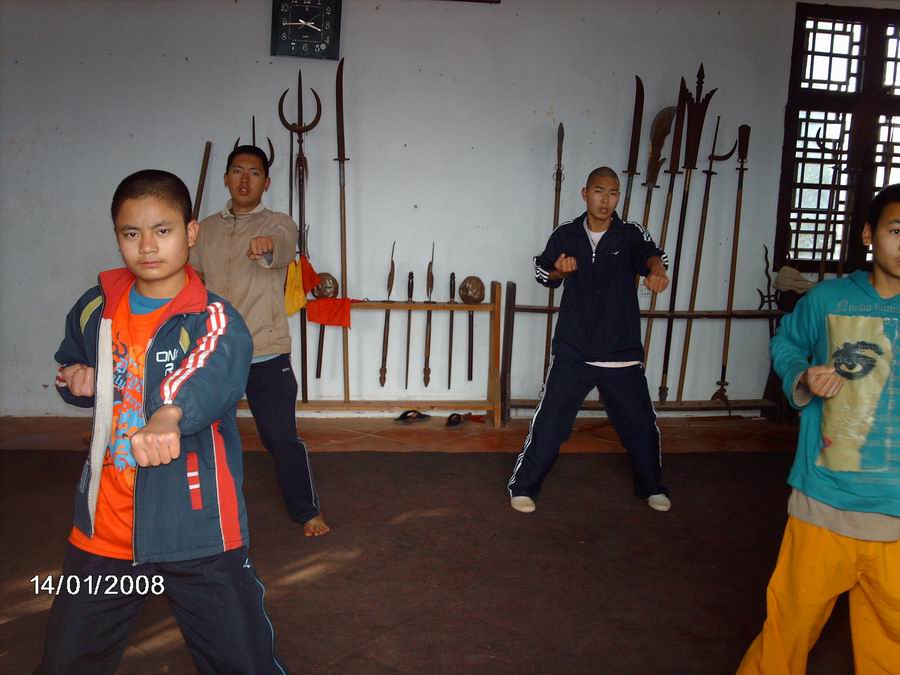 One of the highlights of our visit was the trip to the Dojo/Weapons museum. The Southern
Shaolin had previously had a weapons museum located within the city limits, but have recently sold the building to the Ming
Jang decoration company to help finance their renovation of the Temple compound, and are now in the process of setting up the remaining exhibits in the Temple complex itself. Very sensible move.
At present, however, this is still in the process of being set up, so now all that is currently on display is an interesting
assortment of weapons within the Dojo. We eagerly look forward to the time that the restoration is complete enough to accommodate
all the exhibits.
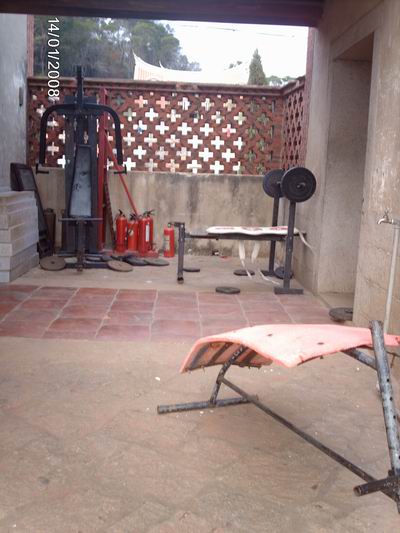 It was also interesting to note the strength training equipment beside the dojo, echoing
Shidoshi Bryce Dallas’s sound reasoning that strength training is an important element of developing one’s martial
arts skills.
Some of our observations have led us to establish a multitude of similarities that provide a preponderance of evidence,
if not incontrovertibly beyond a reasonable doubt (you, the reader can be the judge of that), that Konigun Ninjutsu did, indeed
evolve from Shaolin Kung Fu and bears many remarkable similarities even today, after all these centuries of separate development.
Notwithstanding these similarities, I will preamble this account by stating the obvious; Konigun Ninjutsu and Shaolin
Kung Fu are two very distinctly different styles, each fulfilling it’s own needs, niche, and purpose within the realm
of martial arts. This is the case in comparing any two martial arts; no two arts are ever alike. It is, nonetheless, amazing
to note how many similarities are still present after more than a millennium of separation.
This account will focus on the similarities of weapons, stances, strikes, kicks, blocks, fluidity in movement, angles
of movement, stealth, acrobatics, grapples, groundfighting, use of animal names, harmony of nature, dress, etc, between Konigun
Ninjutsu and its great grandfather, Shaolin Kung Fu, which is regarded by many historians to be the first martial art, brought from India by Tat Moh, also known as Bhoddidharma.
Similar weapons
used include the staff/cudgel, swords (straight and curved), sickle/kama, tonfa, chain, pen, fan, thrown missiles, pitchfork/sai,
a weapon that was handed down from the Shaolin to the Yama Bushi, Short stick or hanbo, 3 section staff, a straw hat used
as a shield, the spear, the sash or belt, and the cane, just to name a few. For more information on Konigun Ninjutsu Weapons
click here
The Yamabushi,
from whom Konigun Ninja derived their training, are also said to have developed the naginata from the Chinese guan dao, a weapon with which the Shaolin still train extensively today.
It was Shaolin
Kung Fu that first used everyday objects as weapons, a tradition proudly perfected by the Ninja. The first documented instance
of this was when the fire tender at the Shaolin temple, Jin Na Luo, used the stoker from the Shaolin Temple
fireplace to defend the Temple against Red Turban invaders.
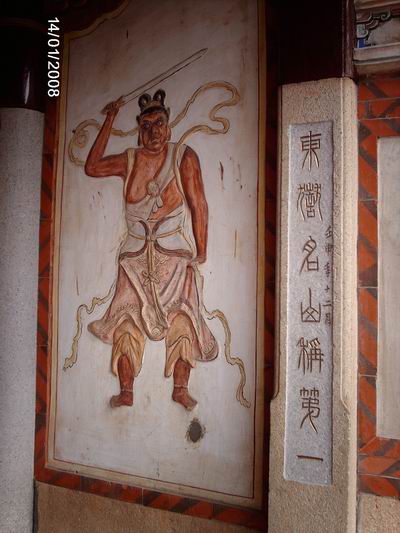 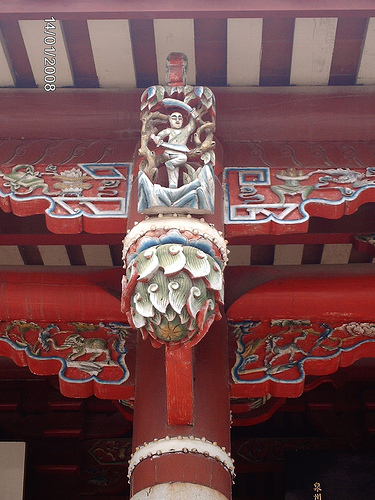
The straight
sword is illustrated in the photo from the Dongchan temple, while the curved sword is shown on the right, as depicted in the
carvings adorning the eaves of the main South Shaolin Temple. The curved blade that was later modified as the samurai’s
katana probably was of Persian influence, as the province of Fujian, and especially the
city of Quanzhou, known in days of old as the fabled port
of aytun, had an enormous Persian population dwelling within it, a fact well documented by explorers such as Marco Polo.
It was noted
that, despite the similarity of the 3 section staff and techniques thereof employed by both arts, the use of the nunchaku
was conspsicuous by its absence.
For more information
on Shaolin Weapons Click Here
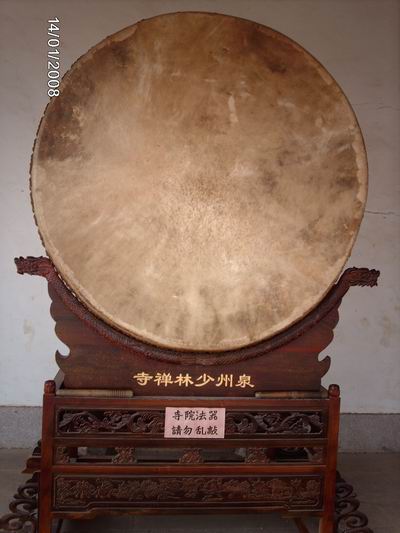
We also discovered
the most likely origin of the short stick on our visit to the Shaolin Temple.
Take note in the photo above of the drum in the main temple. On the left and right, just above the Chinese characters, sit
two short sticks used to beat the drum, but also capable of defeating an able swordsman in the hands of a well trained martial
artist.
Different
weapons include the gong mallet (imagine getting your bell rung by one of those), a common wooden bench, the farmer’s
pitchfork, the hatchet, and a weapon with a fork on one end and a crescent shaped blade on the other used by the Fujianese
to hunt tigers. The different weapons, however, serve to support rather than contradict the similarities between the two styles,
as they provide further evidence that both styles were peerlessly adept at both using obvious weapons and also utilizing everyday
objects as weapons even more effectively. It should also be noted that many sects of Ninjutsu or individual Ninja probably
did use many of the above weapons as circumstances required.
Notably, Shaolin
Kung Fu has developed more weapons that are obviously intended to be used solely as weapons. The reason that this occurred
within Shaolin and not Konigun is probably due to the fact that in feudal Japan
owning or using weapons of any sort by the peasants was strictly forbidden under any circumstances, whereas the
Samurai and nobility could freely own and weild them. In China,
however, no such prohibition has been in force, and weapons have ever been a part of Chinese society, whereas the Japanese
peasants have been forced to defend themselves from oppression using objects that could not be construed as weapons by the
powers that be.
It should
be noted that under the rule of the Chings and Manchurians weapons and martial arts also became outlawed. The principle
difference between China during the Ming rebellion and Japan under Shogunate rule, however, is that the Ming
rebels in Fujian did not recognize the Qing/Manchu regime, and were still loyal to the Ming Emperor, who freely funded
their insurrection, supported their martial arts training, and supplied the Shaolin Monks and the associated lay warriors
with all the weapons they needed.
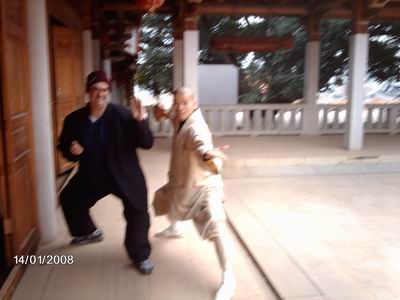
Similar stances
include the L stance, horse stance and draw stance. These stances are pervasively used in almost all martial arts today. Konigun’s
advanced stance is also occasionally used in Shaolin Kung Fu. The deep bend in the knees in a Shaolin stance also indicates
a consciousness of protecting the knees from being broken in combat, which is mirrored in Konigun Ninjutsu and was later built
upon in Konigun to include protection of the elbows as well.
Principle
differences in stances of the two styles include lots of stances in Shaolin Kung Fu with the weight on a deeply bent rear
leg, and the front leg kept forward and almost straight, and frequent shifts in direction of such stances. One could reasonably
speculate that these stances were eliminated from Konigun Ninjutsu with the aim of further reducing the risk of injuries to
the knees due to the development of more brutal, offensive military arts (Imagine getting that lead leg chopped off by a low
blow from a swiftly swung katana, or getting it hooked from underneath by a sickle or kama)
Shaolin Kung
Fu also includes some stances where the placement of the feet is more linear (see the Shaolin Monk above). These were modified
in Konigun Ninjutsu to include wider placement of the feet in interest of increased balance and stability in combat.
Similar strikes
include the basic punch, knifehand, ridgehand, ox hand, clutch palm or tiger claw, punch rolling into a reverse punch, clutch
fist, double punch, spear hand, and double clutch palm. These strikes enable the practicioners of both arts to develop a repertoire
of highly effective and lethal hand techniques.
Mutually practiced
kicks include the whip, side snap (including the same leg motion where the foot is cocked by rotation in front of the body
to gain power and momentum), flying sidekicks to dismount horsemen, front snaps, round kicks, hook kicks, double side kicks
(both simultaneously and in succession) against multiple opponents, the “dragon’s tail” spinning low sweep
and the “tiger’s tail spinning high kick.
The two arts
share very many blocks in common, including side, overhead, neck & head, kidney, cross & parallel blocks. Konigun
Ninjutsu, however, uses the catch block (which I was unable to see used or find reference to in Shaolin Kung Fu, though this
is no guarantee it does not exist).
Fan blocks
and hand rolls, which can also be utilized as strikes, are abundantly present in both arts. Both styles also
perform them both with empty hands and with a full assortment of weapons.
Martial arts
scholars commonly note that one of the primary differences between Kung Fu and Karate is that Karate is harder while Kung
Fu is more fluid. Konigun Ninjutsu shares this fluidity, requiring that katas be not only correct but with a degree of fluidity
that progressively increases as one advances in rank.
Angles of
attack and movement taught in Shaolin Kung Fu and Konigun Ninjutsu are virtually
identical. Shaolin uses eight angles and Konigun uses nine. This is due to the purely semantic difference that Konigun Ninjutsu
refers to the state of motionlessness (void) as an angle while Shaolin Kung Fu does not. These angles are also employed in
both strikes and weapon rolls(twirls) utilizing all weapons through all 3 dimensions
in both Konigun Ninjutsu and Shaolin Kung Fu, including overhead weapon rolls
and passes. Few other martial arts apart from these two focus so intensely on weapon control skills of this nature.
Stealth was
developed by the Shaolin and perfected by the Ninja. Shaolin were the first to institute disguises, especially the decrepit
old man wreaking havoc with his cane and the farmer using his straw hat as a shield and his farm tool as a weapon of mass
destruction.
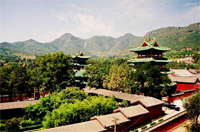 
The nestling
of the Shaolin temples within the mountains and forests also suggests that they were adept at hiding in the woods. This became
perhaps the greatest strength of the Yama Bushi and in turn the Ninja in later years. This is depicted above by the Henan
North Shaolin Temple, as the reconstruction efforts presently detract from the picturesque beauty to which the South Shaolin
Temple will soon be restored.
Another aspect
of stealth shared by Shaolin & Ninja alike is hidden weapons and attacks. Practitioners of both arts employ all manner
of small weapons hidden within their clothing, or disguised as innocuous objects on their persons.
A perfect
illustration of these hidden attacks within Konigun Ninjutsu is in the Monjin Kata, where a tiger’s eye strike to the
ocular region from the rear striking arm is hidden behind the lead forearm until the last instant before impact, followed
up by low reverse spear hand that suddenly snakes out from under the lead forearm too late to defend against. In both cases
the movement of the lead hand also provides misdirection to aid the striking hand.
Acrobatics
shared by Konigun Ninja and Shaolin Monks include rolls (front, back, barrel [used to ascend or descend steps and hills while
under attack]) cartwheels, flying kicks, jumps from extraordinarily high structures, tightrope walks, rolls under and over
weapons and opponents, high cartwheels and vaults with the staff, just to name
a few.
Grapples shared
by both Konigun Ninjutsu and Shaolin Kung Fu include weapons grapples (both with the hand and under the arm), the grappling
of kicks, the grappling of strikes and weapons using round kicks, overarm strike and weapons grapples, and throat punch takedowns
(later made more effective and lethal in Konigun Ninjutsu). It is highly important to note that it was these grapples developed
by the Shaolin that lay the foundation for the development of the comprehensive system of joint and bone breaks upon which
the system of Taijutsu so adroitly employed within the style of Konigun Ninjutsu is predicated.
It should
be noted, however, that Konigun Ninjutsu uses far more grapples and block and catch moves preparatory to these grapples as
part of its superlatively sensible evade, control and conquer approach to any attack. This evade, control, and conquer approach
is, as well, a derivative of White Crane Kung Fu, which was also a Shaolin adaptation. Indeed, White Crane's Philosophy of "Sieze and Control" lay the perfect foundation for Konigun Ninjutsu's "Evade, Control,
Conquer".
"Official research in China has traced the origins and history of the White Crane style of Kung Fu. The founder of the
style was Fan Qiang Liang daughter of a famous Wushu Master. They moved to Fujian province after the death of her mother In
the best tradition of kung fu her father died defending her honor from unwelcome suitors. Only seventeen at the time . she
vow revenge, joining a temple as a nun.
It is said that during this time she dreamt that she was fighting a white crane but it evaded her attacks easily, using
its powerful wings to strike back at her . After the third night of this dream she realized that she should adapt her fighting
style to incorporate the crane agility and grace, its ability to strike quickly and accurately." (Courtesy of KungFu-Taichi.com)
The two styles
also share remarkable similarities in ground fighting techniques, including the grappling of a punch and pulling the arm across
the body to take control of an opponent atop oneself, barrel roll evasions and grapples, lying crossblock grapples, etc.
The use of
animal names for techniques or styles derived from Shaolin Kung Fu and is carried on by Konigun Ninjutsu. Examples of this
include bear crawls, tiger crawls, snake crawls, dragon crawls, crane fist, praying mantis form, white crane form, snake technique,
monkey style, frog hops (practiced by both arts), duck walks, Monkey Steals the Peach, etc.
A particularly
notable illustration regarding animal names and techniques is the evolution of the clutch palm, known as the tiger claw by
the Shaolin Monks, amongst the Ninja. The tiger claw was more than simply a clutch-palm; it involved, upon impact, the raking
of the fingernails in a manner similar to that of a tiger attacking its opponent in battle. This technique was perfected by
the Ninja with the development of the Shuko (hand spikes).
Harmony with
nature was a precept taught and striven for by both Shaolin Monks and Ninja in general. It is interesting that the colloquialism
of Ninjutsu within the Konigun Style is also recognized as the study of nature. The proximity of the Shaolin
Temple to the forest, where the monks spend much time meditating, also
substantiates this relationship. The carvings of trees and animals, as well as the maintenance of Gardens throughout the Temple speaks of this as well.
It can also
be said that much of Bushido itself can be traced back to the tenets of the Shaolin Monks. This is especially true of the
obligations to God, self, family, ryu, community, etc, as well as the admonitions to respect all living things and to never
strike a vengeful blow.
The common
bond of dress between Konigun Ninjutsu and Shaolin Kung Fu, the use of a sash, is both traditional and functional. The sash
in both styles is sacred, representative of one’s efforts to attain it; so much so that a Konigun disciple’s sash
is never permitted to touch the ground while detached from the uniform, nor may it ever be washed (so doing is symbolic of
washing away one’s experience).
Functionally,
the sash plays the obvious role of holding one’s pants up, clearly important in combat unless one desires to shock one’s
opponent for good or for ill. Secondly, the sash is utilized for carrying weapons at one’s side in both styles. Last
but not least, the sash in and of itself can be a weapon that has lethal potential in grappling, as well as effectively striking
vital regions such as the throat or groin if properly wielded. The placard shown above indicates that the Shaolin are
also aware of the sash’s value as a weapon.
These are
but a few of the similarities and contrasts between two venerable arts, two of the finest and most comprehensive in the entire
world. Volumes could (and eventually will) be dedicated to further elucidation of these similarities and contrasts, but the
primary purpose here is to address the most rudimentary aspects of Konigun Ninjutsu’s proud and noble Shaolin heritage,
which was so graciously bestowed upon our forefathers in the Saija family by the Yama Bushi of old. We hope that this dissertation
will encourage you to explore the martial arts further for yourself, especially Konigun Ninjutsu, which I personally feel
is the most effective and comprehensive martial art one can study. This is why, being in a position that I can study any martial
art I desire, I choose to study and practice Konigun Ninjutsu first and foremost.
Respectfully
yours,
Monjin Trey
Woodford.
Special thanks
to Dr. Bill Brown, an MBA professor at Xiamen University, whose writings were of impreciable assistance in carrying out this
visit to the Shaolin Temples, and whose historical insights were also of great help in composing this write-up. If you are
planning to visit the Shaolin
Temple, the Fujian province, or just want to know
more about one of the most beautiful and culturally rich areas of China,
please visit Dr. Bill’s website at www.amoymagic.com
|

